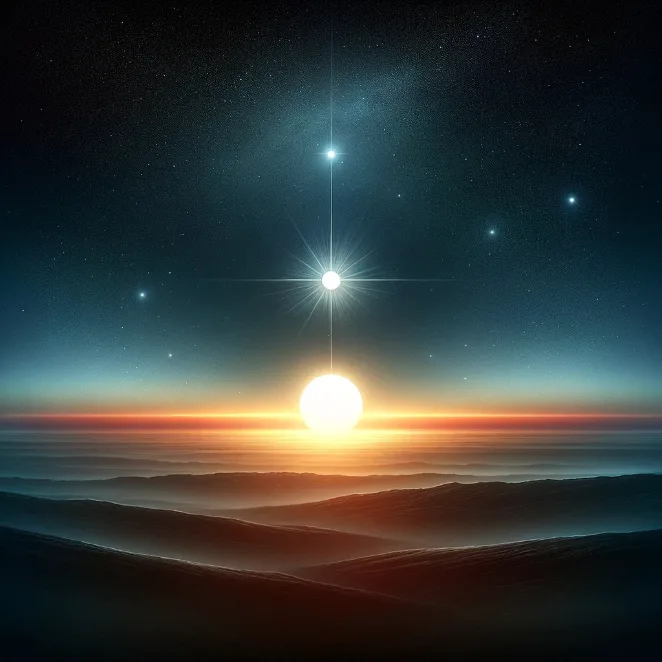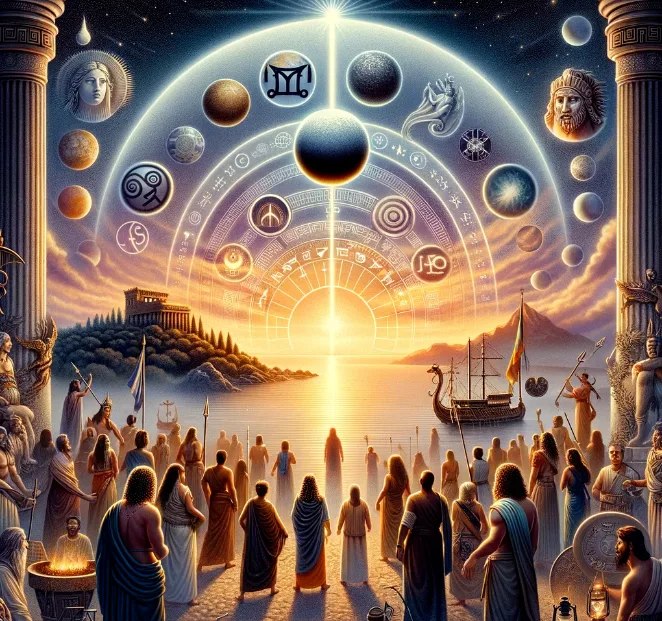
Mercury as the Morning Star: Celestial Herald of Dawn
Mercury, the smallest member of our solar system, extends its influence far beyond its physical size, captivating our imagination both as an astronomical body and a mythological symbol. Its unique orbital path around the Sun allows it to shine as both the Evening Star and the Morning Star at different times. This article focuses on Mercury's intriguing role as the Morning Star, exploring not only its astronomical journey but also the rich tapestry of symbolism it weaves as it heralds the break of dawn.
article by Priya Deshmukh
Mercury's Morning Appearance: An Astronomical Marvel
The phenomenon of Mercury's appearance as the Morning Star is a fascinating astronomical event that occurs periodically throughout the year. This event is marked by Mercury reaching its greatest western elongation from the Sun, which positions the planet as a bright, visible object in the early morning sky just before the sun rises. During this phase, which lasts for several weeks, Mercury rises just before dawn, often visible against the horizon's faint glow. Its swift movement and proximity to the Sun lend Mercury a fleeting yet significant presence in the sky, distinguishing it from the slower orbits of other celestial bodies. This brief appearance as the Morning Star highlights Mercury's dynamic nature and its role as a celestial herald of the new day.

Mercury in Mythology: The Swift Messenger
Mercury’s role in mythology is as diverse as it is profound, embodying characteristics that mirror its astronomical behavior. In Roman mythology, Mercury was revered as the messenger of the gods, known for his speed, agility, and ability to traverse between the earthly and divine realms. These attributes are poignantly reflected in the planet's rapid transit across the sky. In Greek mythology, he was Hermes, the quick-footed deity who moved swiftly between worlds, serving as a messenger and intermediary. This dual nature of Mercury, bridging the earthly and the divine, marks it as a figure of great mythological significance, weaving stories that have endured through millennia.

The Cultural Resonance of Mercury in Dawn's Light
The cultural significance of Mercury rising as the Morning Star is deep-rooted in human history and spans across various civilizations. For ancient cultures like the Greeks and Romans, the emergence of Mercury in the morning sky was a symbol of renewal and the onset of new chapters. It was seen as a cosmic indicator of transition, ushering in a shift from the darkness of night to the light of day. Such appearances were often viewed as auspicious, marking ideal moments for starting new communications or ventures. The enduring cultural impact of Mercury as the Morning Star emphasizes its role beyond a mere astronomical phenomenon, highlighting its integral part in the human narrative of change and progression.
Astrological Implications of Mercury as the Morning Star
In the realm of astrology, the phase of Mercury as the Morning Star is associated with a period of enhanced mental clarity and communicative ability. It is seen as a time when assertiveness in expressing ideas and initiating conversations is heightened. Astrologically, this phase is considered conducive to the free flow of thoughts and words, with an increase in mental acuity. It represents an opportunity for individuals to engage in intellectual pursuits, share knowledge, and make effective decisions. This period is often interpreted as ideal for brainstorming, problem-solving, and kick-starting new projects, as it is believed to bring a sharpened focus and clear thought process.
Observing Mercury: A Spectacle for Sky Enthusiasts
Observing Mercury in its Morning Star phase offers a unique opportunity for both amateur skywatchers and professional astronomers. This experience does not require sophisticated equipment but benefits greatly from a clear horizon and minimal light pollution for optimal viewing. The best time to observe Mercury during this phase is approximately an hour before sunrise, looking towards the eastern horizon. Although Mercury's visibility is not as prominent as Venus, its fellow Morning Star, its appearance remains a noteworthy event in the astronomical calendar, offering a glimpse into the dynamic nature of our solar system.

Mercury's Morning Phase: An Epoch of Intellectual Renaissance
The Morning Star phase of Mercury is seen as an era of intellectual awakening and clarity. Astrologers often recommend this period as an ideal time for heightened attentiveness in matters of communication, travel, and contractual agreements, attributing a potent influence to Mercury. It is a phase that favors educational activities, the exchange of ideas, and intellectual collaborations, particularly benefiting those in fields of writing, education, and communication. The presence of Mercury in the morning sky during this phase acts as a cosmic cue, inspiring a renewed focus on mental pursuits and the articulation of thoughts and ideas.
Mercury continues to enchant as the Morning Star, symbolizing the dynamic and evolving nature of our world. Viewed through various lenses – astronomical, mythological, astrological, or artistic – Mercury’s emergence in the early morning sky serves as a testament to its unique position within our solar system and in the collective human consciousness. Its dual role as both the Evening Star and the Morning Star mirrors the ever-changing rhythm of life, reminding us of the interconnectedness of the celestial and the terrestrial in the grand tapestry of existence.
Published: 11/14/2023
Modified: 11/14/2023
More predictions
Come back here soon to learn more about yourself and your future


The Role Of The Moon In Human Life
From ancient folklore to modern science, the Moon has always captivated the human imagination. As our closest celestial neighbor, it wields a mysterious power over our lives, both mythologically and physically. Let's dive into the manifold ways the Moon impacts human existence.


Astrology’s Insight Into Discovering Your Soulmate
In the boundless realms of stars and planets, astrology meticulously crafts a pathway that ostensibly guides individuals toward understanding their ideal companions – the enigmatic soulmates. As we meander through life, the quest for that one person who harmonizes with our essence becomes pivotal.


Tracing the Roots of Zodiac Signs
The horoscope signs, central to astrology, have fascinated humans for millennia. These twelve signs, forming the zodiac, are more than just symbols; they are a testament to ancient humanity's quest to understand the cosmos. The origin of these signs is a blend of astronomy, mythology, and symbolism, deeply embedded in various cultures. This article explores the fascinating history and origins of the horoscope signs, unraveling their journey from celestial observations to astrological symbols.